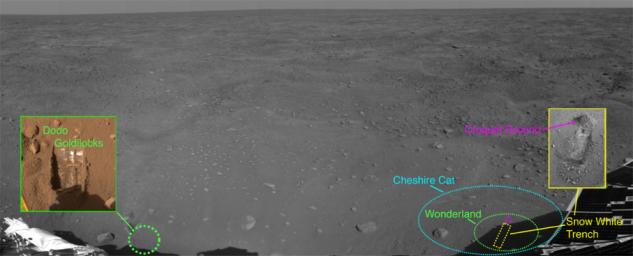
|
Phoenix’s Lay of the Land
- Click the image above for a larger view
- Full-Res JPEG (1200 x 486) (79.8 kB)
- Full-Res TIFF (1200 x 486) (1.8 MB)
Caption:
This image from NASA's Phoenix Mars Lander shows the spacecraft's recent activity site as of the 23rd Martian day of the mission, or Sol 22 (June 16, 2008), after the spacecraft touched down on the Red Planet's northern polar plains. The mosaic was taken by the lander's Surface Stereo Imager (SSI). Parts of Phoenix can be seen in the foreground.
The first two trenches dug by the lander's Robotic Arm, called "Dodo" and "Goldilocks," were enlarged on the 19th Martian day of the mission, or Sol 18 (June 12, 2008), to form one trench, dubbed "Dodo-Goldilocks." Scoops of material taken from those trenches are informally called "Baby Bear" and "Mama Bear." Baby Bear was carried to Phoenix's Thermal and Evolved-Gas Analyzer, or TEGA, instrument for analysis, while Mama Bear was delivered to Phoenix's Microscopy, Electrochemistry and Conductivity Analyzer instrument suite, or MECA, for a closer look.
The color inset picture of the Dodo-Goldilocks trench, also taken with Phoenix's SSI, reveals white material thought to be ice.
More recently, on Sol 22 (June 16, 2008), Phoenix's Robotic Arm began digging a trench, dubbed "Snow White," in a patch of Martian soil near the center of a polygonal surface feature, nicknamed "Cheshire Cat." The "dump pile" is located at the top of the trench, and has been dubbed "Croquet Ground." The digging site has been nicknamed "Wonderland."
The Snow White trench, seen here in an SSI image from Sol 22 (June 16, 2008) is about 2 centimeters (.8 inches) deep and 30 centimeters (12 inches) long. As of Sol 25 (June 19, 2008), the trench is 5 centimeters (2 inches deep) and the trench has been renamed "Snow White 1," as a second trench has been dug to its right and nicknamed "Snow White 2."
Background Info:
The Phoenix Mission is led by the University of Arizona, Tucson, on behalf of NASA. Project management of the mission is by NASA's Jet Propulsion Laboratory, Pasadena, Calif. Spacecraft development is by Lockheed Martin Space Systems, Denver.
Photojournal Note: As planned, the Phoenix lander, which landed May 25, 2008 23:53 UTC, ended communications in November 2008, about six months after landing, when its solar panels ceased operating in the dark Martian winter.
Cataloging Keywords:
| Name | Value | Additional Values |
|---|---|---|
| Target | Mars | |
| System | ||
| Target Type | Planet | |
| Mission | Phoenix | |
| Instrument Host | Phoenix Lander | |
| Host Type | Lander | |
| Instrument | Solid-State Imaging (SSI) | |
| Detector | ||
| Extra Keywords | Color, Thermal | |
| Acquisition Date | ||
| Release Date | 2008-06-23 | |
| Date in Caption | 2008-06-12 | 2008-06-16, 2008-06-19 |
| Image Credit | NASA/JPL-Caltech/University of Arizona/Texas A&M University | |
| Source | photojournal.jpl.nasa.gov/catalog/PIA10908 | |
| Identifier | PIA10908 | |
